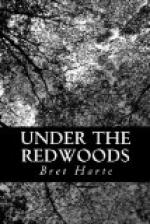But his intention was never fulfilled. For when days and weeks had elapsed, and he had vainly haunted the river estuary and the rocky reef before the lighthouse without a sign of her, he overcame his pride sufficiently to question Jim. The man looked at him with dull astonishment.
“Olooya gone,” he said.
“Gone!—where?”
The Indian made a gesture to seaward which seemed to encompass the whole Pacific.
“How? With whom?” repeated his angry yet half-frightened master.
“With white man in ship. You say you no want Olooya—forty dollars too much. White man give fifty dollars—takee Olooya all same.”
UNDER THE EAVES
The assistant editor of the San Francisco “Daily Informer” was going home. So much of his time was spent in the office of the “Informer” that no one ever cared to know where he passed those six hours of sleep which presumably suggested a domicile. His business appointments outside the office were generally kept at the restaurant where he breakfasted and dined, or of evenings in the lobbies of theatres or the anterooms of public meetings. Yet he had a home and an interval of seclusion of which he was jealously mindful, and it was to this he was going to-night at his usual hour.
His room was in a new building on one of the larger and busier thoroughfares. The lower floor was occupied by a bank, but as it was closed before he came home, and not yet opened when he left, it did not disturb his domestic sensibilities. The same may be said of the next floor, which was devoted to stockbrokers’ and companies offices, and was equally tomb-like and silent when he passed; the floor above that was a desert of empty rooms, which echoed to his footsteps night and morning, with here and there an oasis in the green sign of a mining secretary’s office, with, however, the desolating announcement that it would only be “open for transfers from two to four on Saturdays.” The top floor had been frankly abandoned in an unfinished state by the builder, whose ambition had “o’erleaped itself” in that sanguine era of the city’s growth. There was a smell of plaster and the first coat of paint about it still, but the whole front of the building was occupied by a long room with odd “bull’s-eye” windows looking out through the heavy ornamentations of the cornice over the adjacent roofs.




